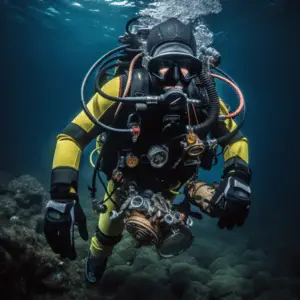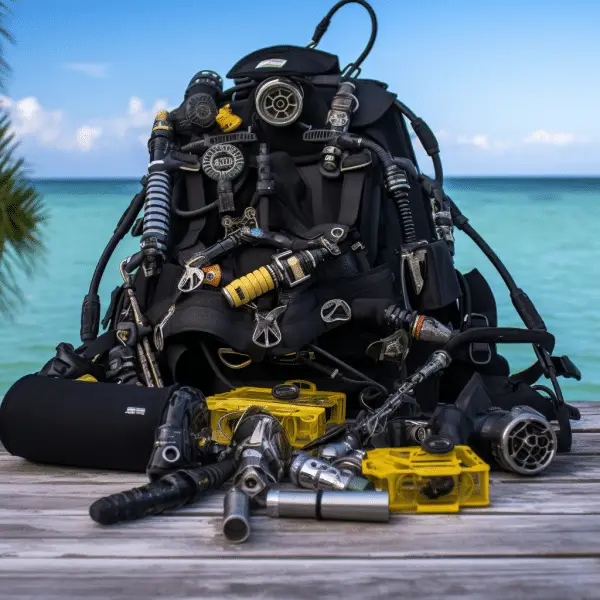
Scuba diving equipment: Embark on an exhilarating underwater adventure with scuba diving! But first, make sure you have the right gear. Masks, fins, regulators, and tanks are all essential.
Masks create an air pocket around your eyes. That way, you can see clearly and protect your eyes. Fins give you power in the water. With each kick, they propel you through the depths.
Regulators are a must-have. They reduce the high-pressure air in your tank to a breathable level. Without them, you wouldn’t be able to breathe underwater.
Tanks store the air or gas mix you breathe while diving. Metal cylinders, usually aluminum or steel, come in different sizes. Keep your tank well-maintained for a constant air supply.
Fun fact: Emile Gagnan and Jacques-Yves Cousteau created the first effective scuba regulator in 1943. Thanks to this invention, modern scuba diving is now possible. Before, divers had to use bulky, surface-supplied systems, which limited their exploration.
Essential Scuba Diving Equipment
Scuba diving needs special tools to have a secure and fun time. These tools are key for discovering the underwater world, so let’s get going!
- Have a peek at important scuba diving equipment in the table below:
| Equipment | Description |
|---|---|
| Dive mask | Clear view & protects eyes underwater |
| Snorkel | Breathe while at the surface |
| Fins | Move smoothly in the water |
| Buoyancy compensator | Adjusts buoyancy & keeps you steady |
| Regulator | Gives air from the tank to breathe underwater |
| Dive computer | Monitors depth, time & decompression limits |
| Wetsuit/drysuit | Warms you in cold waters or protects from stingers |
| Weight system | Achieves the right buoyancy with added weights |
Apart from the basic scuba diving equipment, there is more to consider. Safety is the number one priority, so certified training is essential. Plus, you must service & maintain gear for the best performance and safety.
To show the importance of having good quality scuba diving equipment, here’s a true story.
A few years ago, I had a fantastic dive in a place that was full of different marine life. Sadly, one diver had a regulator problem. But, he changed it quickly with his spare regulator. This meant he could still be part of the expedition.
This experience taught me how important it is to take backups when scuba diving. It makes it safer and it’s a great way to explore under the sea.
Optional Equipment
Optional scuba diving gear can add convenience, safety, and more! Dive computers give real-time info like depth and time. Underwater cameras let divers document marine life. Dive lights light up the dark or low-light spots. SMBs (Safety Sausages) indicate a diver’s position on the surface.
In the past, scuba diving was much simpler. But now, technology has revolutionized diving gear. So, optional equipment is popular among enthusiasts. It can help ensure a safer dive and capture stunning photos. These pieces of equipment offer divers valuable tools to make the most out of their underwater adventures.
Tips for Choosing Scuba Diving Equipment
Scuba diving is an epic experience that needs the right gear for safety and enjoyment under the sea! Here are some tips for choosing scuba diving equipment:
- 1. Dive Mask: Get one that fits and offers a great view of the ocean.
- 2. Snorkel: Look for a comfy mouthpiece and ease of breathing.
- 3. Fins: Secure and powerful fins for efficient swimming.
- 4. Wetsuit or Drysuit: Choose based on water temperature.
- 5. BCD (Buoyancy Control Device): Adjustable straps + quick-release for buoyancy control.
- 6. Regulator: A regulator that works well at deeper depths.
Take into account your personal needs and preferences when selecting scuba gear. Extras like dive computers, cameras, and lights may be chosen by some divers.
Safety is top-priority with scuba gear. Have certified professionals inspect and maintain it regularly. By following these tips and taking necessary precautions, divers can have a peaceful adventure underwater.
Know this – PADI says that there are over 6 million certified scuba divers worldwide!

Conclusion
To end, scuba gear is essential for a great underwater experience. From basic items like masks, fins, and regulators to special equipment like dive computers and cameras – each has a key part in making the dive better.
Also, it’s important to think about quality and fit. Good-fitting masks and fins make sure there are no leaks and the diver is comfortable. High-grade regulators and tanks are vital for supplying air at different depths.
Moreover, buying a reliable dive computer can help with safety by tracking time, depth, decompression limits, and other info. This lets divers plan their dives safely.
Plus, underwater cameras can capture spectacular moments underwater and let people share them.
Additionally, there are other accessories that make diving better. Dive lights offer visibility in darker areas or at night. BCDs help divers stay neutrally buoyant underwater. And wetsuits keep them warm in colder waters.
To sum up, each piece of scuba gear is important for security, comfort, and fun when diving. By getting good quality gear that fits and adding extras, divers can have an incredible time exploring underwater.
Frequently Asked Questions
Q: What are the essential pieces of scuba diving equipment?
A: The essential pieces of scuba diving equipment include:
- Mask: A mask allows you to see underwater by creating an air pocket for your eyes.
- Fins: Fins help you move efficiently through the water with less effort.
- Regulator: A regulator supplies you with air from the scuba tank and allows you to breathe underwater.
- BCD (Buoyancy Control Device): A BCD helps you control your buoyancy by adjusting the amount of air in it.
- Wetsuit or Drysuit: A wetsuit or drysuit keeps you insulated and protects you from the cold water.
- Dive Computer: A dive computer monitors your depth, dive time, and nitrogen levels for safe diving.
Q: Can I rent scuba diving equipment?
A: Yes, most dive shops and dive resorts offer equipment rental services. However, it is recommended to have your own equipment for comfort, familiarity, and hygiene reasons. Renting equipment is a good option for beginners or occasional divers.
Q: How much does scuba diving equipment cost?
A: The cost of scuba diving equipment varies depending on the brand, quality, and specific items you purchase. On average, a basic set of gear including a mask, fins, regulator, BCD, and wetsuit can cost anywhere from $1000 to $2000. However, it is important to invest in high-quality equipment for safety and durability.
Q: How often should scuba diving equipment be serviced?
A: Scuba diving equipment should be serviced annually or as recommended by the manufacturer. Regular servicing ensures that all components are working properly and minimizes the risk of equipment failure during a dive. It is crucial to follow the manufacturer’s guidelines for maintenance and service intervals.
Q: Are there any additional tools or accessories that I need as a scuba diver?
A: In addition to the basic scuba diving equipment, some useful tools and accessories for divers include a dive knife or cutting tool for emergencies, a surface marker buoy for safety signaling, a dive light for better visibility in darker conditions, and a compass for navigation underwater. These items are not essential for every dive but can enhance your diving experience.
Q: Can I dive without formal scuba training?
A: It is highly recommended to undergo formal scuba training before attempting a dive. Scuba diving involves specific skills and knowledge to ensure safety underwater. Proper training from a certified instructor will teach you essential techniques, safety procedures, and how to properly use scuba equipment. It is important to prioritize your safety and the safety of others by getting certified before diving.
